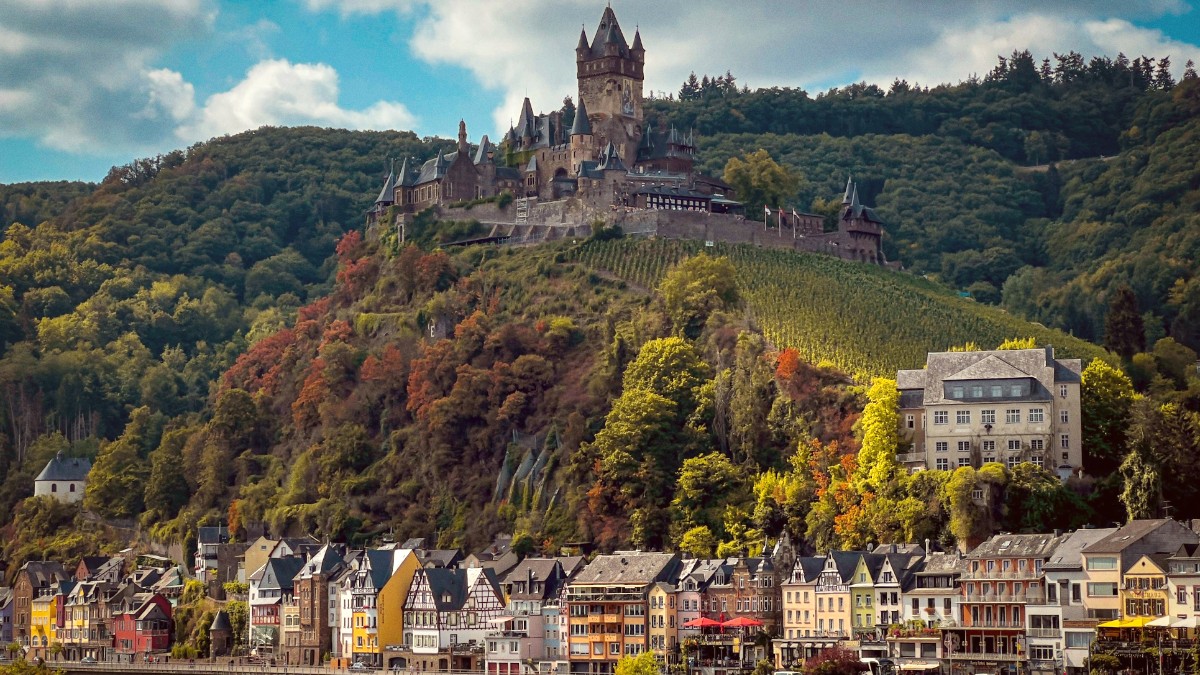
Rhineland Palatinate, Germany
The Rhine Valley boasts several instantly recognizable landmarks that define its unique character. Must-visit sites with historical and cultural context include the legendary Loreley Rock, the Deutsches Eck in Koblenz, and Marksburg Castle. These sites symbolize the romantic allure and mystical nature of the Rhine, and highlight Germany's history.
A charming collection of historic toys and automated musical instruments, offering a nostalgic journey through mechanical wonders.
Gives a comprehensive look at the history of wine culture, viticulture, and winemaking techniques in Germany.
Many smaller towns along the Rhine, like Bacharach or Boppard, feature various local art galleries and exhibition spaces, demonstrating the work of regional artists. These present a chance to purchase unique pieces.
The Rhine Valley is rich in history, with numerous sites bearing witness to centuries of human activity.
Explore the remains of a large Roman amphitheater and a sophisticated aqueduct system, reminders of Mainz's importance as a Roman settlement.
Parts of this former Roman frontier, an UNESCO World Heritage site, run through the region. You can visit reconstructed watchtowers and sections of the wall.
Wander through its charming streets, discovering half-timbered houses, historic squares, and the impressive Romanesque cathedral.
Features narrow alleys, historic squares, and the elegant Electoral Palace, reflecting its history as a princely residence.
These towns are quintessential medieval Rhine towns. They boast remarkably well-preserved half-timbered houses, sections of old town walls, and impressive castle ruins that transport visitors back in time.
The Niederwald Monument in Rüdesheim commemorates German unification. The Deutsches Eck in Koblenz, with its Kaiser Wilhelm I statue, symbolizes German unity at the confluence of the Rhine and Moselle rivers.
Mainz Cathedral (Mainzer Dom) is over 1000 years old, one of Germany's most historically important cathedrals. St. Kastor Basilica in Koblenz is a Romanesque basilica and site of important historical meetings. Numerous charming churches along the Rhine have historical or artistic value.
The Rhine Valley is specifically rich in military heritage due to its strategic importance. Ehrenbreitstein Fortress in Koblenz is a large and well-preserved example of Prussian military architecture. Marksburg Castle provides an authentic look at medieval military life. Other castles like Rheinfels, Katz, Maus, and Pfalzgrafenstein are testaments to centuries of conflict.
Beyond its historical sites, the Rhine Valley displays natural beauty, from serene parks to dramatic landscapes.
Beyond the well-trodden paths, the Rhine Valley holds many hidden gems that offer unique and authentic experiences.
Discover lesser-known but equally captivating sites.
Places rarely visited by typical tourists, offering deep local insights.
Capture the Rhine Valley's beauty from fresh perspectives.
Tips for moving around and exploring the valley's treasures.
Beyond its historical sites, the Rhine Valley displays natural beauty, from serene parks to dramatic landscapes.
Mainz City Park is a large, green space with a beautiful rose garden, creating a peaceful retreat. Rhein-Anlagen in Koblenz is a picturesque riverside promenade and park ideal for strolls. Loreley-Park is a landscaped park at the Loreley Plateau.
The Loreley Rock stands dramatically. Vierseenblick (Four Lakes View) in Boppard is a famous panoramic viewpoint where the winding Rhine creates an illusion of four lakes, accessible by chairlift. The Binger Mäuseturm is a small, picturesque tower on an island in the Rhine.
Diverse habitats along the Rhine support varied birdlife, with birdwatching opportunities along riverbanks. The dramatic slopes of the Rhine Valley are a significant geological feature, carved through ancient slate rocks, creating deep gorges and steep hillsides.
The main waterway, generally not suitable for swimming due to strong currents and heavy commercial traffic.
A volcanic crater lake in the nearby Eifel region (a short drive from the Rhine). It permits opportunities for swimming and various watersports in a natural setting.
Smaller designated swimming lakes (Badeseen) exist in the broader region. Look for signs indicating approved swimming spots for a safe dip in summer.
While the main Rhine has heavy traffic, kayaking and canoeing are possible on quieter sections of the Moselle River (which joins the Rhine at Koblenz).
The surrounding nature parks offer further opportunities for wildlife viewing and peaceful natural exploration, beyond the immediate river banks.
Places rarely visited by typical tourists, offering deep local insights.
Capture the Rhine Valley's beauty from fresh perspectives.
The Rhine Valley offers a rich blend of history, culture, and nature. From iconic landmarks to hidden gems, there is much to discover.
Utilize the regional train lines for easy access between towns and consider a boat cruise for unparalleled river views.